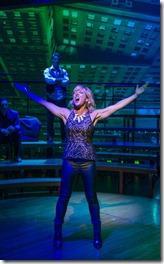
Company
Focus on the scenes make for a smart interpretation
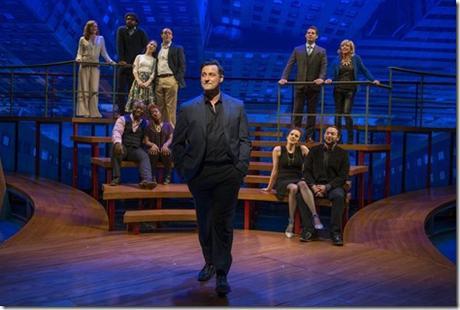
It's hard to believe, given how popular Sondheim is among Chicago theatre companies and theater-goers, that the area hadn't had an Equity production of Company in 20 years (!!) or so. Easily one of Sondheim's most accessible and universally resonant musicals, it's generally a popular choice. Maybe it's that it's a damned tricky piece to pull off. Chicago-born librettist George Furth, in creating this meditation on the institution of marriage, gave us 10 characters - 5 husbands and 5 wives - that are not archetypes, but complex people who are difficult to figure out. Furth, who died in 2008, was a friend of mine, and I remember him telling me that acting is all about communicating the things the characters are feeling but don't say. In his script for Company , which he began as a
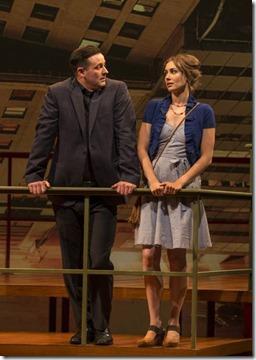
The first of the five couples - all friends of the 35-year-old bachelor Robert (or Bobby, or Bobby-Baby, Bobby-bubby, or Robbo as he's variously named affectionately by his married friends) - are Harry and Sarah. The two are loving, but competitive and combative. Harry's trying to quit drinking after a couple of DUIs and Sarah's trying to diet. Both are secretly cheating on their vows of abstinence, but not really fooling anyone. Their little deceptions give them more fodder to needle each other. James Earl Jones II and Alexis Rogers as the husband and wife capture their loving but competitive relationship with humor and in a departure from traditional casting, a dash of African-American sensibility. We next meet David and Jenny (Patrick Martin and Blair Robertson) - parents of young children who agree to try marijuana with their single buddy Robert after the kids are asleep. This is a particularly difficult scene to play, with David, Jenny and Robert all babbling and contradicting themselves while under the influence. Brown and cast unlock it, showing that - despite all the characters' attempts at politeness - David is really a little conflicted about being committed to the responsibilities of parenthood and marriage to a sweet but socially conservative wife. Frankly, after seeing at least 12 other productions of this musical, this is the first time that scene has completely made sense to me. Brown also scores big with the closing scene of the first act, in which long-time unmarried but living together Paul and Amy are about to finally get married. Allison Hendrix as Amy, without losing the humor of her patter song "Getting Married Today" (in which tells the audience empathetically that she's "not"), gives a sense of her genuine fear of the institution. As her good-guy intended Paul, Bernard Balbot is a kind and empathetic figure as well.
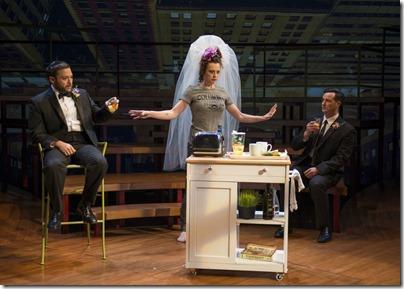
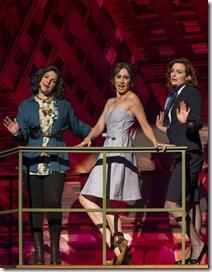
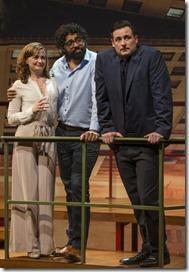
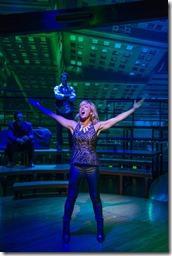
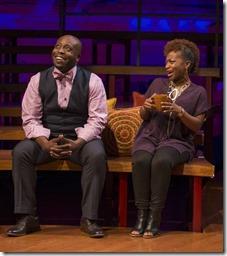
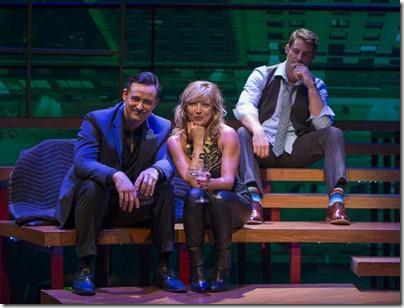
So that's three of the five couples Brown and company nail. He doesn't do as well with Peter and Susan - another couple with kids, but one that drops the bombshell that they are about to become happily divorced. The scene is usually played for comic relief, but as performed by Gabriel Ruiz as Peter and Tiffany Scottas the southern bell Susan, the jokes fail to land and the result is neither charming nor insightful.
Then there's Joanne. The thrice-married, probably alcoholic wife of rich husband Larry, who fears she's just a trophy wife though Larry claims to be "daily fascinated" by her. Lia Mortensen comes off as merely a shrill and angry Joanne - not really showing her character's frustration at being only an appendage to her three husbands - one of the rich "Ladies Who Lunch" in the show's 11 o'clock song made famous by the original Joanne, the iconic Elaine Stritch. Mortenson reads younger than Joanne is usually played, and looks great in the spandex costume she's given. Paired with the also younger-than-usual casting of Patrick Sarbas Larry, it's a little harder to buy Joanne's lament that the couple is "too young for the old people and too old for the young people." They look about the same age as the others, frankly.
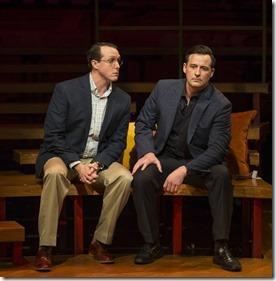
That said, directors and actors do have to commit to a certain view of the character, and Brown and Thom Miller, playing Bobby, have chosen to play him as a rather shallow sort. Charming, always trying to say the right thing, but rarely revealing many of his own feelings. This is all fine, up to a point, but when Bobby gets to his final catharsis, in which he admits to loneliness in the song "Being Alive," we're not really invested enough in him to feel that epiphany along with him. Part of the blame for that can be given to Brown's decision to mix and match versions of Furth and Sondheim's texts. When was revived, first on Broadway in 1995 and immediately following by Sam Mendes in London in 1996, the writers made some revisions, mostly to add depth to Bobby's character. Those who've seen the show before may miss the scene in which Bobby receives an unexpected (and unwelcome) sexual advance from Peter that was added to the 1995 revision. It's missed because it was helping to create a rising tension in Act Two that showed Bobby's single lifestyle becoming increasingly unsatisfactory for him. Brown also reinstates a number found in the original, but cut from the revision called "Tick Tock." It's an instrumental (arranged by David Shire from Sondheim's melodies) that in the original version accompanied a dance solo representing Bobby and April's one-night sexual encounter as well as the more affectionate lovemaking of the married couples. Instead of a dance, Brown uses it to underscore simulated sex between Bobby and April followed by mini-scenes with the couples showing differing aspects, a disturbing physical fight between Joanne and Larry that turns into sex. This directorial touch is intriguing, but it interrupts the second act's otherwise focus on Bobby.
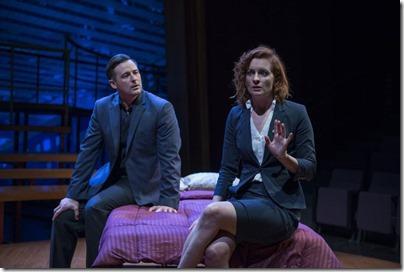
Among the girlfriends, Chelsea Morgan creates a warm Kathy - the girl Robert should have married and Christine Mild as Marta does a knockout delivery of "Another Hundred People," Sondheim's sardonic hymn to the transitory social relationships of life in NYC. Jess Godwin offers an unusual take on April, the flight attendant that's usually played as dim, but here is just harsh and rather odd.
The action is played out against a giant window frame in Todd Rosenthal's set, looking out on a painted Manhattan streetscape as if viewed an upper story window. lights the painting differently at various moments of the play to match the mood and timeframe of the scene.
Brown's staging very clearly gives the feeling that the various scenes in this non-linear concept musical are Bobby's memories, playing out in random order as he contemplates his life upon reaching age 35 - roughly the midpoint of an American male's life expectancy in 1970. We appreciate Brown's treating the script as a serious piece of dramatic art, even if his pace is a little sluggish for a musical. Company seems to be a bit of Rubik's Cube - try to "fix" one aspect of it and some other problem can pop up. That's reason enough to see multiple productions of it. This is a good one, that unlocks many of the meanings and mysteries of the script while doing a winning job with the Sondheim score as well.
continues through July 31 August 7th at Writers' Nichols Theatre, 325 Tudor Court, Glencoe (), with performances Tuesdays-Fridays 7:30pm, Saturdays 3pm & 7:30pm, Sundays 2pm & 7:30pm. Tickets are $35-$80, and are available by phone (847-242-6000) or online through their website (check for half-price tickets at Goldstar.com ). More at WritersTheatre.org. (Running time: 2 hours 30 minutes, includes 15-minute intermission)
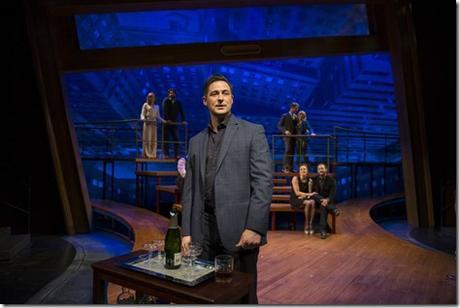
Michael Kaish (piano, conductor), BJ Cord (trumpet), Dan Johnson (trombone), Nick Moran (woodwinds), Vijay Tellis-Nayak (keyboards, guitars), Michael Sinclair (upright, electric bass), Jeff Handley (drum set, percussion)
behind the scenes
William Brown (director), Tom Vendafreddo (music director), Brock Clawson (choreographer), Todd Rosenthal (scenic designer), Rachel Anne Healy (costume designer), (lighting designer) , Josh Horvath (sound designer), Jonathan Tunick (original orchestrations), Ian Weinberger (orchestral reductions), David Castellanos (production stage manager), Michael Kaish (conductor, asst. music director), Nick Moran (music contractor), Bobby Kennedy (dramaturg), Ericka Mac (asst. director), Eric Parks (assistant to the director), Janelle Boudreau (asst. stage manager), Caleb McAndrew (technical supervisor), Scott Dickens (props master), Jane Heuer (wardrobe supervisor), Emily Waecker (costume supervisor), Simon Robinson (master electrician), Amanda Hosking (sound engineer), Michael Brosilow (photos)
Tags: 16-0650, Alexis J. Rogers, Allison Hendrix, Amanda Hosking, Bernard Balbot, BJ Cord, Blair Robertson, Bobby Kennedy, Brock Clawson, Caleb McAndrew, Chelsea Morgan, Chicago musical theater, Chicago Theater, Christine Mild, Dan Johnson, David Castellanos, Emily Waecker, Eric Parks, Ericka Mac, Gabriel Ruiz, George Furth, Ian Weinberger, Jacquelyne Jones, James Earl Jones II, Jane Heuer, Janelle Boudreau, Jeff Handley, Jess Godwin, Jesse Klug, John Olson, Jonathan Tunick, Josh Horvath, Kimberly Mellen, Lia Mortensen, Michael Brosilow, Michael Kaish, Michael Sinclair, Molly Dral, Nichols Theatre, Nick Moran, Patrick Martin, Patrick Sarb, post, Rachel Anne Healy, Rob Riddle, Scott Dickens, Simon Robinson, Stephen Sondheim, Thom Miller, Tiffany Scott, Todd Rosenthal, Tom Vendafreddo, Vijay Tellis-Nayak, William Brown, Writers' Theatre
Category: 2016 Reviews, John Olson, Musical, Nichols Theatre, Stephen Sondheim, Video, Writers' Theatre, YouTube

